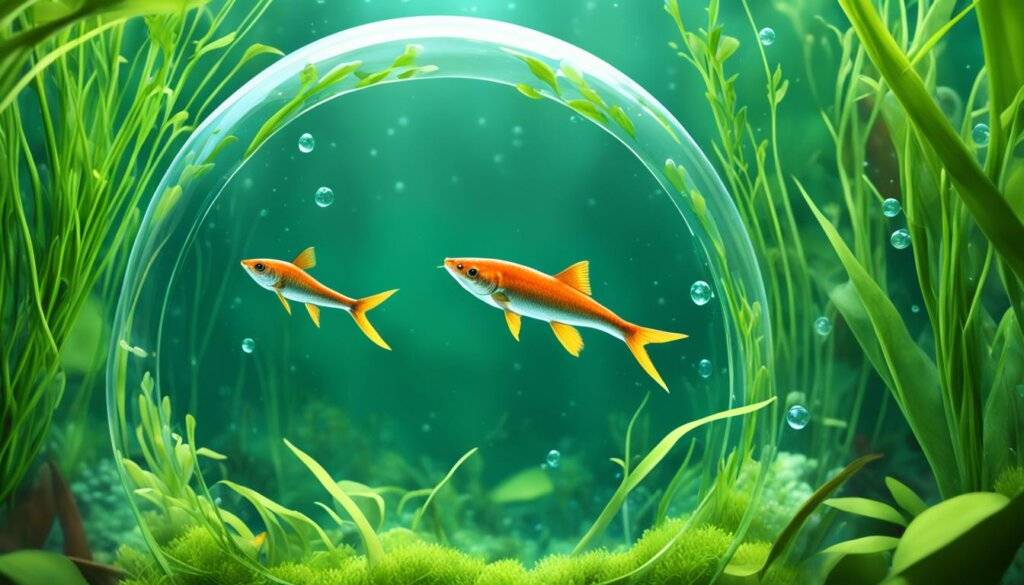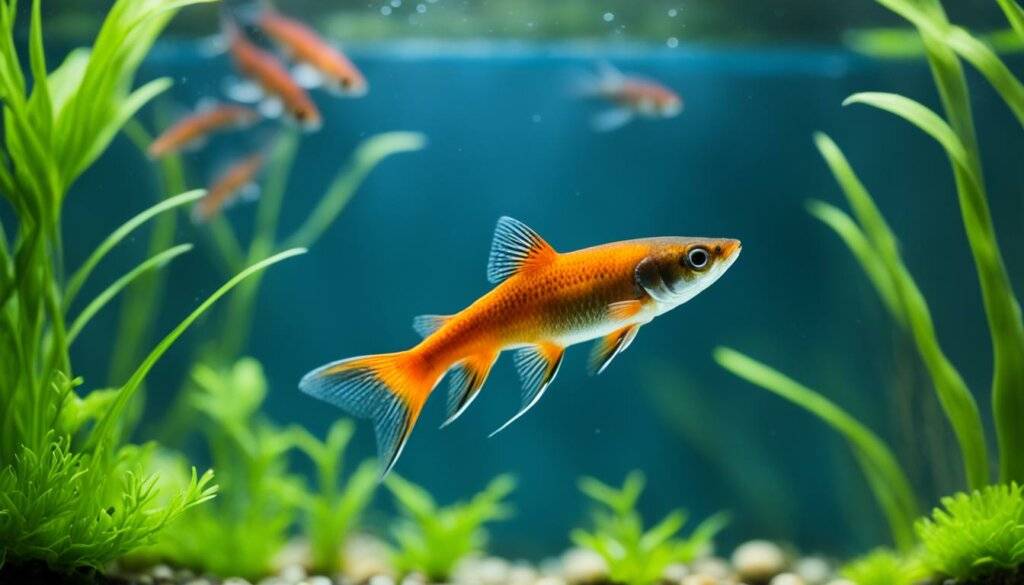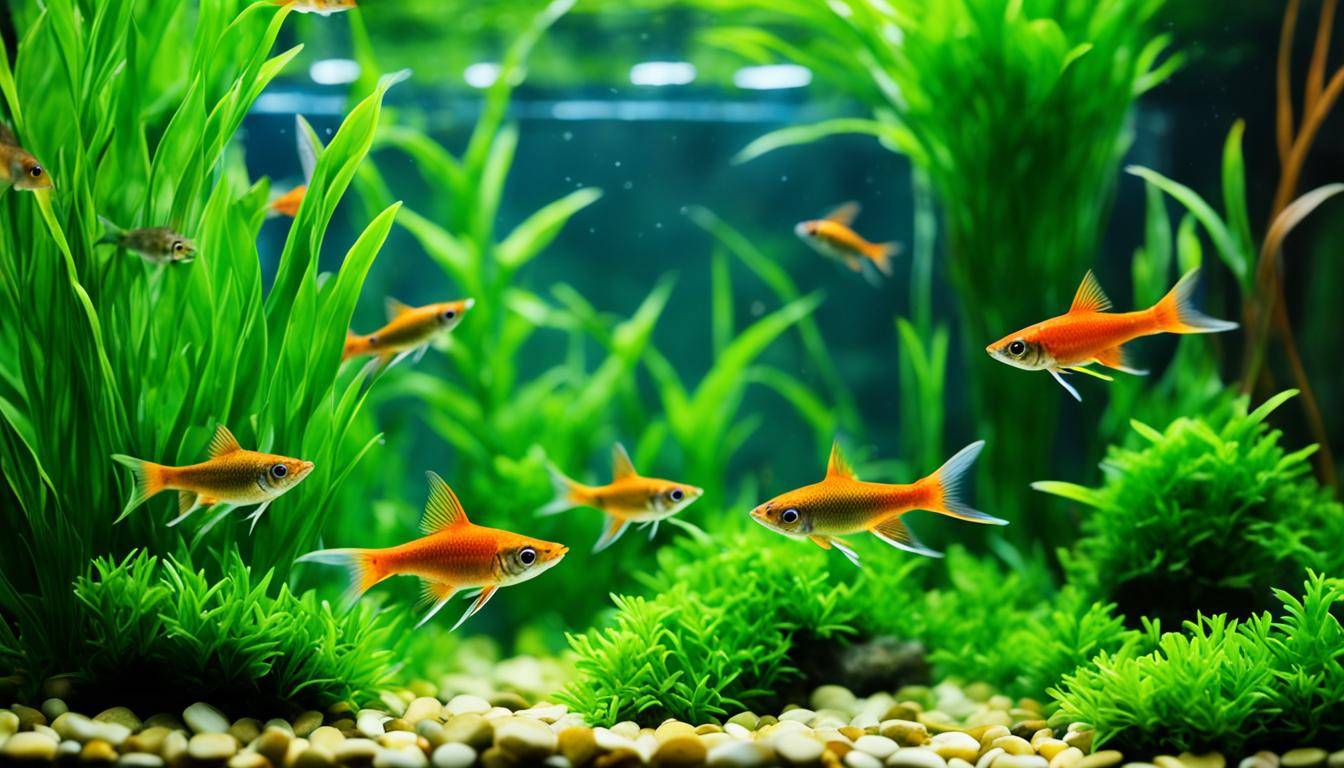Welcome to your beginner’s guide on Rasbora fish! If you’re new to aquariums or want an easy fish, you’re in the right spot. Rasboras are small, colorful, and peaceful. They come from Southeast Asia and are tough. This guide will teach you all about caring for and breeding Rasboras.
Preparing for Breeding Rasboras
To breed Rasboras successfully, you need to prepare well. Here are the important steps to ready your breeding tank:
1. Select a Separate Breeding Tank
A separate tank is a must for breeding. Choose the right size tank for your Rasboras.
2. Set the Ideal Water Parameters
Rasboras do best in soft, slightly acidic water. Adjust your water so it has the right pH for breeding. Keep the pH level between 6.0 and 7.0 for the best results.
| Water Parameters | Ideal Range |
|---|---|
| pH Level | 6.0 – 7.0 |
| Temperature | 74°F – 82°F |
3. Provide Suitable Lighting and Plants
Dim lighting helps mimic their natural breeding environment. Also, add plants like Java moss. They look good and give eggs a safe spot to rest.
- Soft, slightly acidic water is key for breeding.
- Keep pH levels between 6.0 and 7.0.
- Temperature should stay between 74°F and 82°F.
- Java moss or spawning mops are great for eggs.
4. Select a Fully Grown Breeding Pair
Picking a grown pair of Rasboras is crucial for breeding. Males are usually smaller and colorful. Females are bigger, with rounder bellies and less color.
“By selecting a mature breeding pair, you increase the chances of successful breeding and healthy fry.” – Experienced Rasbora breeder
Fully grown pair:
- Male: Smaller, more colorful
- Female: Bigger, rounder, less colorful
Once you’ve done these steps, you’re all set to start breeding. You’ll soon see new life in your tank.
The Breeding Process
Once you select a breeding pair of Rasboras and get them used to the isolation tank, you can start breeding. Watching the natural behaviors and beauty of these fish is thrilling. Let’s look at what you need to do to breed Rasboras.
1. Belly Swelling and Vibrant Colors
When the female Rasbora is ready to lay eggs, she will get a swollen belly. This means she is prepared for breeding. The male Rasbora, at the same time, shows brighter colors. He does this to attract the female and show he’s ready to fertilize the eggs. Watching this colorful display is like seeing Rasboras in a love dance.

-
Save
2. Mating Dance and Egg Fertilization
Rasboras sometimes do a mating dance before the eggs are fertilized. This dance has special movements and swimming patterns. It shows the connection between the breeding pair. When the female is ready, she scatters her eggs on plants in the tank. The male then fertilizes the eggs, starting the development of new life. Seeing this is quite special.
Please remember, the breeding process takes hours. You need to be patient. Let the Rasboras do their thing at their own speed. It might be hard, but try not to interrupt them. It’s best to let nature take over.
3. Removing Adult Fish
After the eggs are fertilized, take the adult fish out of the breeding tank. Adult Rasboras might eat their eggs, which could harm the future fry. To avoid this, move the breeding pair back to their original tank after fertilization is done.
| Step | Description |
|---|---|
| Step 1 | Select a breeding pair and acclimate them to the isolation tank. |
| Step 2 | Observe the female’s belly swelling with eggs and the male displaying more vibrant colors. |
| Step 3 | Witness the mating dance or display before the female scatters her eggs and the male fertilizes them. |
| Step 4 | Be patient as the breeding process may take several hours. |
| Step 5 | Remove the adult fish to prevent them from eating the eggs. |
Congrats! You’ve finished the breeding process. The next part will talk about taking care of the fry after breeding. It’s important for their health and growth.
Post-Breeding Care
After the eggs are fertilized, giving the right care is key for the fry to grow well. Once fertilized, move the adult fish out of the breeding tank. This stops them from eating the eggs. They can go back to their original home or another good place.
To help the fry grow, you need a special tank. This tank needs dim light and soft air to keep them safe and healthy. Keep the water between 75°F to 80°F.
About a day or so after fertilization, you’ll see tiny fry moving in the tank. They’re small and need the right food. Starting them on infusoria or liquid food is a good idea. These are full of nutrients and easy for fry to eat.
As fry get bigger, their food needs change. By a week, they can eat baby brine shrimp. These shrimp are full of protein which helps fry grow strong. Make sure they have enough to eat as they grow fast during this time.
Soon, the fry will look like tiny versions of their parents. Their colors and patterns will start to show. Keeping their tank clean and feeding them right is important for their growth. Watch the water closely and feed them regularly.
Tips for Post-Breeding Care:
- Remove adult fish after fertilization to prevent them from eating the eggs.
- Use an isolation tank that is dimly lit and has soft aeration.
- Ensure water temperature is within the recommended range (around 75°F to 80°F).
- Feed the fry infusoria or liquid fry food initially, and switch to baby brine shrimp after about a week.
- Monitor water parameters regularly and perform regular water changes to maintain optimal conditions.
By giving good post-breeding care, you help the fry grow into beautiful, vibrant Rasboras.
| Post-Breeding Care | Description |
|---|---|
| Remove adult fish | Prevents them from consuming the eggs |
| Isolation tank | Dimly lit, with soft aeration |
| Water temperature | Maintained within the recommended range (around 75°F to 80°F) |
| Fry food | Start with infusoria or liquid fry food, then transition to baby brine shrimp |
| Water parameters | Monitor regularly and perform water changes to maintain optimal conditions |

-
Save
Conclusion
Seeing life begin in your aquarium is rewarding. When you breed Rasboras, you fill your tank with life. Each Rasbora is different, so care varies. Stay observant, keep learning, and enjoy every step.
Breeding these fish lets you see nature’s magic. Watching their mating dances and egg-laying is amazing. You help preserve these beautiful creatures. Give them the right food and a safe place to grow. Then, see them become tiny copies of their parents.
Raising Rasboras means more than just waiting for babies. It’s about the whole experience. You get to understand nature’s complex beauty. Start this journey and fill your aquarium with color and life. Enjoy the world of Rasboras.
